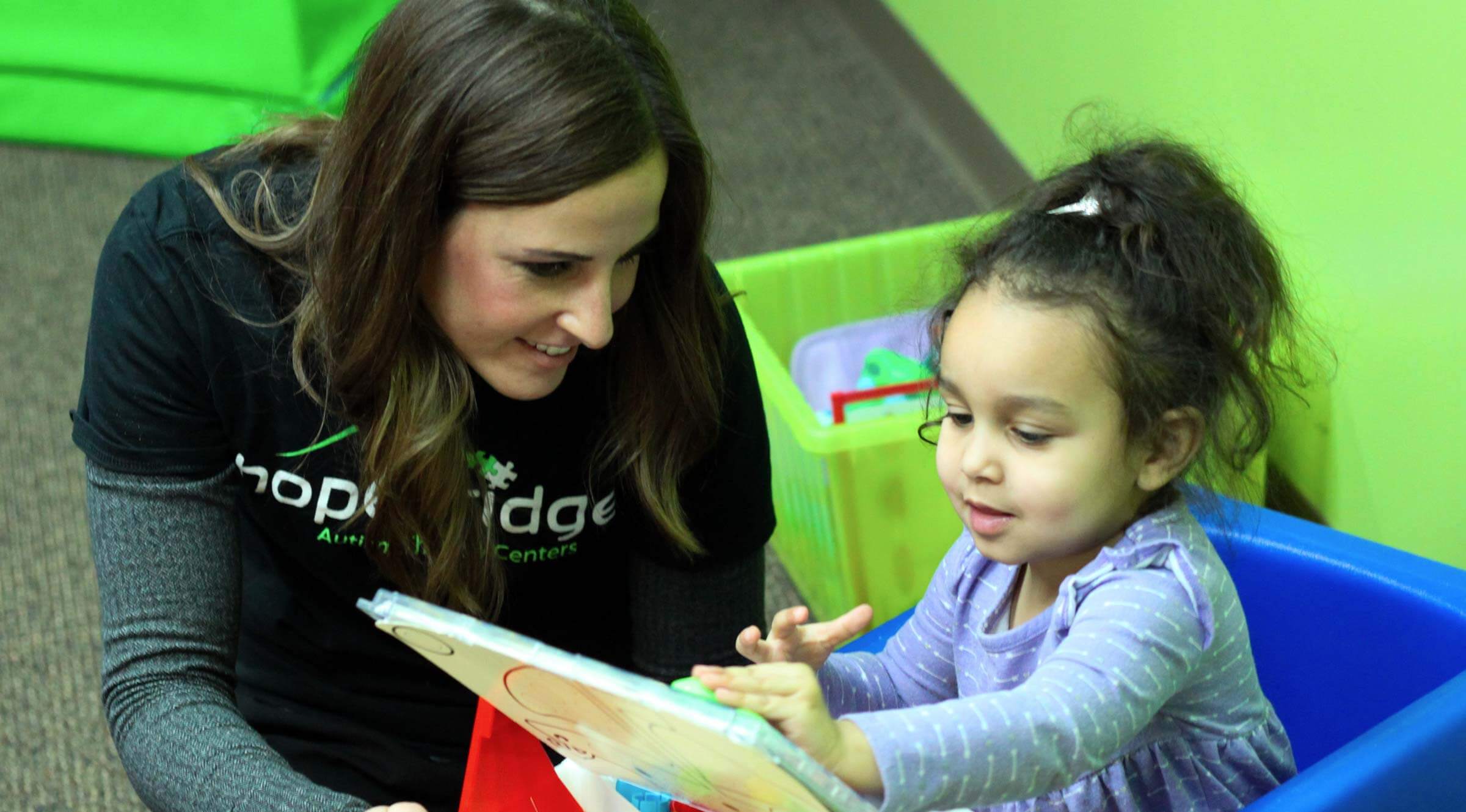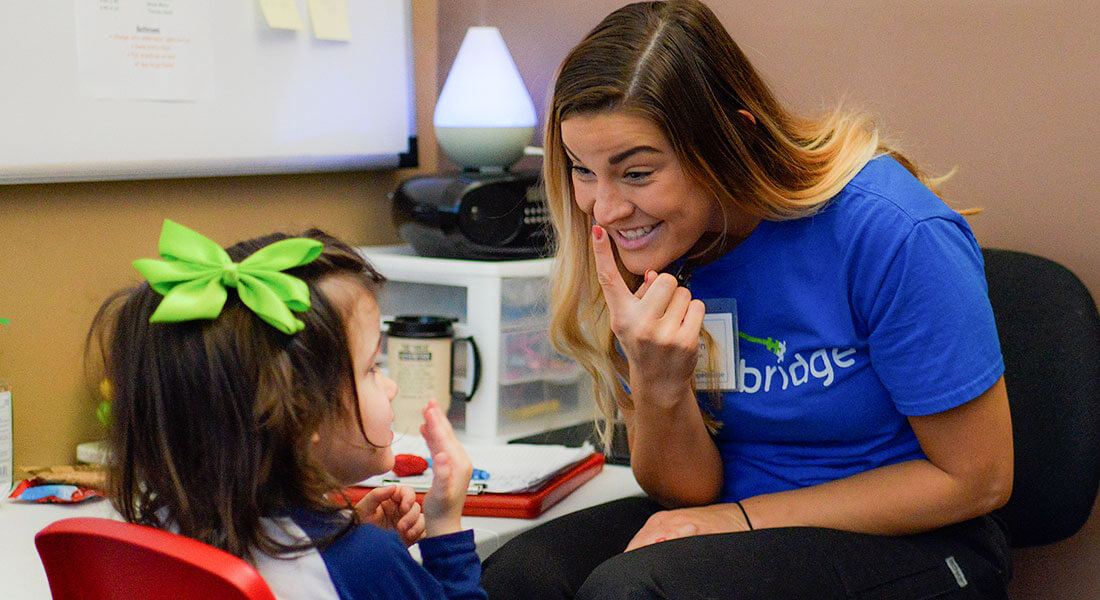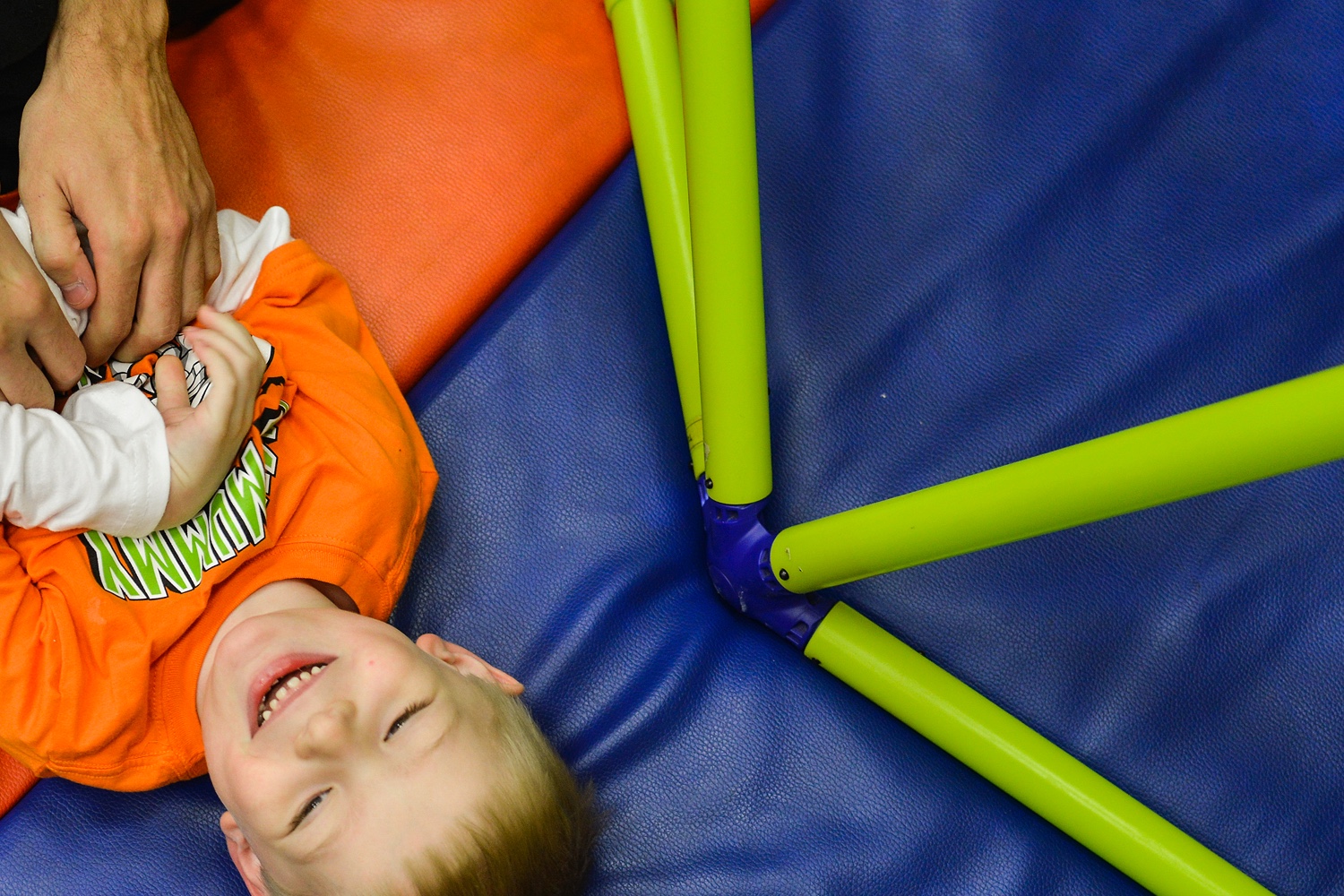
Girl with autism in therapy
Therapy Services & Strategies
Types of therapies and methods Hopebridge offers kiddos
Applied Behavior Analysis (ABA therapy)
ABA therapy is a scientific, behavior management approach. Within the autism field, it is known to be an effective, evidence-backed intervention. It’s a way to shape and mold actions for effective communication and learning by utilizing basic principles of behavior, special techniques and positive reinforcement. Since this is such a hot topic for us, we provide a more detailed definition within our ABA Breakdown on the Hopebridge website.
Discrete Trial Training (DTT)
Also known as “Discrete Trial Teaching,” DTT is often used as part of an ABA therapy program. It is a structured method of one-on-one instruction in which skills are broken down and taught in smaller, isolated components, often repeatedly and with the help of reinforcements (see “reinforcer” definition below). A behavior therapist records responses, and once a task is mastered, the therapy evolves and a new task is presented in order to build towards a bigger skill.
Early Intensive Behavioral Intervention (EIBI)
In the autism community, EIBI is the use of evidence-based, individualized instruction and treatment using principles of ABA to teach adaptive behaviors to young children with ASD. There are various models of EIBI, but the general term refers to intervention services that are intended to occur at a high intensity of 25 to 40 hours per week that occur as early as possible, but specifically before the patient is 7 years old. A number of scientific studies indicate EIBI may lead to large gains in development and lessen the need for special supports later in life.
Feeding and Swallowing Therapy
From building tolerance to strengthening muscles, this combination of therapies is focused on helping kiddos with autism overcome a range of eating obstacles. For instance, sensory-related feeding challenges like food aversions can be treated with help from occupational therapy and ABA therapy. Mechanical issues with chewing or swallowing are approached from a speech therapy angle. More information on Hopebridge’s feeding services can be found on the Hopebridge website.
Natural Environment Training (NET) / Naturalistic Teaching
NET is a teaching method under the ABA umbrella in which ongoing learning exercises take place in an individual’s natural settings, everywhere from a home or therapy room to a playground or grocery store. Teaching opportunities are incorporated while the individual is engaging in regular activities, such as a child playing. The practice is individualistic; driven by the patient and his or her initiation and spontaneity is often rewarded. For a more detailed description and benefits, view the post on NET as part of the Hopebridge BCBA series.
Occupational Therapy (OT)
In the pediatric realm, OT is a treatment support that is built around learning and play, since that is how children occupy their time as they grow. The therapy focuses on building foundational skills, such as those related to fine motor, perceptual and cognitive, handwriting, self-care, feeding, social and sensory-processing. For more detail, learn more about occupational therapy at Hopebridge.
Pivotal Response Training (PRT)
Sometimes referred to as “Pivotal Response Treatment,” PRT falls under the ABA umbrella and takes a behavior-analytic approach to target communication, social interaction and independence. The method organizes concepts in a particular fashion in order to teach certain pivotal behaviors. It starts with finding a variety of ways to motivate a child and giving multiple cues, all to encourage self-management and self-initiation in social settings. For more information, view the blog post on PRT from the BCBA series.
Speech Therapy (ST)
This practice involves more than vocal speech. The pediatric practice involves teaching children how to communicate what they want in a way that can be understood by others. This ranges from developing oral motor skills to make sounds and words, to participating in conversations to create meaningful relationships, it is often centered around building language skills. Augmentative and alternative communication (see definition below) may also be involved for patients who need a different way to voice their needs, and feeding and swallowing may also be incorporated for children who need support in those areas. Learn more about speech and feeding therapies on the Hopebridge website.
Sensory Integration Therapy
Sensory integration is the process of the brain organizing and interpreting information through touch, body awareness, movement, smell, taste, vision and hearing. Some children have difficulties with adapting to these incoming sensations, which can lead to learning or developmental challenges. Sensory integration therapy exposes these children to sensory stimulation in a structured, repetitive yet gradual way in an effort to teach the nervous system to respond in a different way.

Young child with ASD in a therapy session
Therapy Support
Tools and roles that play a crucial part in therapy
Augmentative and Alternative Communication (AAC)
Children with autism may have speech delays and through evaluations, are found to need another form of communication to aid them in expressing their wants and needs. AACs encompass the wide range of ways to communicate without talking, from gestures and sign language, to PECS (see definition below) and speech tablets.
Behavior Support Plan (BSP)
Also known as Behavior Intervention Plan (BIP), a BSP is developed based on a Functional Behavior Assessment for function-based treatment of impeding behaviors. A behavior plan includes both preventative and responsive strategies for safe and effective behavior management. It also includes teaching strategies for the development of more appropriate “replacement” behaviors intended to serve the same function as the challenging behavior.
Board Certified Behavior Analyst (BCBA)
A BCBA is a behavioral health professional who has graduate-level certification to provide ABA therapy services (see definition above). The BCBA is the lead in designing ABA therapy programs built around skill acquisition and behavior modification. In addition, this role is tasked with evaluating the effectiveness of ABA therapy programs and supervising the team when implementing prescribed services. More information about the BCBA role at Hopebridge can be found on the website.
COTA (Certified Occupational Therapy Assistant)
COTAs perform much of the same work as occupational therapists, but under the supervision of a an OTR (see definition below). They provide treatment and follow same plan of care, but do not conduct initial evaluations or standardized assessments.
Functional Behavior Assessment (FBA)
An FBA is a process that identifies a child’s specific behavior challenges that are interfering with progress, but especially focuses on defining the reasons behind the behaviors. The objective is to use these underlying reasons to develop intervention plans to teach the child to instead use positive, alternative behaviors.
OTR (Registered Occupational Therapist)
OTRs provide occupational therapy to patients, with a registration that includes a master’s degree and the passing of board exams. In addition to treating children, pediatric OTRs conduct patient evaluations, perform standardized assessments, create plans of care, report on and analyze progress and manage transitions.
Picture Exchange Communication System (PECS)
PECS is a type of augmentative communication (see definition above) used by children who may not yet have effective language skills. The six-phase program is a pyramid approach to education, through which a child learns to communicate wants, needs and feelings, as well as engage in conversations. The program builds various skills in each phase before adding an additional layer of objectives and skills. PECS first uses pictures before moving onto words, and eventually sentence strips. The phases of PECS and its benefits are outlined in a blog post from the Hopebridge BCBA series.
Reinforcer / reinforcement
Positive reinforcement is a widely used principle of ABA for skill acquisition. Reinforcers are specific to the individual and are identified through preference assessments. Positive reinforcement is delivered throughout a session to increase motivation and make learning fun. Reinforcers are often thought of as tangible objects, like a tablet or snack, but can also be intangible actions, like praise, a special tone from a familiar voice, or even the excitement of working fast to get something finished.
Registered Behavior Technician (RBT)
An RBT is a therapist who works one-on-one with individuals with autism to directly implement the ABA treatment programs designed and guided by BCBAs (see definition above). The RBT is responsible for building communication, social interactions, problem-solving and adaptive living skills. More information about the RBT role can be found on the Hopebridge website.
SLP (Speech-Language Pathologist)
SLPs have graduate-level certification and provide speech therapy to patients. These professionals are responsible for conducting assessments, diagnosing certain communication and swallowing-related disorders and delays, designing plans of care, treating patients, reporting on and analyzing progress and managing transitions.
Token Economy
A token system is often used during DTT or as part of a behavior support plan to positively reinforce specific responses or behaviors. Tokens are given to the individual, often on a chart, for completing tasks or behaving in desired ways. Tokens are then exchanged for preferred items or activities.
Visual Schedule
Also known as a “picture schedule,” this is often used as part of a program to help the learner transition from activity to activity throughout the session. Learning to follow a visual schedule is a significant skill within an ABA therapy program. A graphic outline of the day’s tasks and activities, the tool helps children understand rules, routine (and sometimes more importantly, changes in routine), and ultimately, independence.

Toddler in daily ABA therapy
Diagnostics
Diagnoses and testing instruments used to determine challenges and design plans of action
ABLLS-R (Assessment of Basic Language and Learning Skills-Revised)
The ABLLS-R is an assessment, curriculum guide and skills-tracking system developed specifically for children with autism. It is often used as part of an individual’s program to guide goal selection in the areas of communication (expressive and receptive), social, play, academic and adaptive skills.
Asperger’s Syndrome
Asperger’s was previously viewed as a separate diagnosis from autism, but it currently falls under the umbrella of autism spectrum disorder, according to the DSM-5 (see definitions of ASD and DSM-5 below). Many of the signs and symptoms overlap with autism, however symptoms often appear less severe in individuals who identify with Asperger’s, and they typically do not exhibit language delays or cognitive impairments.
Assessment / Evaluation
In the worlds of autism and pediatric mental health, there are a number of scenarios that involve assessments and evaluations. From the initial autism diagnosis to therapeutic cases, these terms refer to the collecting of information in areas that affect the child, such as psychological, behavioral, social, language and more. Assessments focus on the individual’s needs, which then influence next steps and recommended services.
Autism Diagnostic Interview-Revised (ADI-R)
A standardized clinical diagnostic instrument for assessing autism, the ADI-R focuses on behavior in social interaction; communication and language; and restricted and repetitive behaviors. The ADI-R is a measurable, interview that requires a qualified clinician to administer it to a parent and score. It is useful for diagnosing autism and planning treatment.
Autism Diagnostic Observation Schedule (ADOS)
The ADOS, of which the second edition is currently in use, is a semi-structured assessment that allows licensed clinicians to accurately evaluate and diagnose autism spectrum disorders across ages, developmental levels and language skills. ADOS incorporates multiple modules and is implemented through standardized behavior observation and coding of communication, social interaction and play for individuals who may show signs of autism. It takes approximately 40 to 60 minutes to administer.
Autism Spectrum Disorder (ASD)
The range of autism is broad and the term means something different to everyone, but the clinical definition of ASD is a neurological, developmental disorder that can cause social, communication and behavioral challenges. According to the criteria outlined in the DSM-5, it lies on a spectrum, as the name suggests, and ranges from low-functioning to high-functioning autism. Deeper information on ASD can be found on the Hopebridge website.
Developmental Delay
A child who has a developmental delay is someone who does not reach certain milestones or perform various cognitive, communication, social, emotional, behavioral or physical skills by an expected age. These delays can be associated with autism, but are not always connected to ASD nor another underlying medical condition.
DSM-5 (Diagnostic and Statistical Manual of Mental Health Disorders, 5th Edition)
The DSM-5 is the handbook published by the American Psychiatric Association and used by health care providers to guide the evaluation of mental disorders. It serves as an authoritative volume that defines and classifies mental disorders in order to improve diagnoses, treatment and research.
Sensory Profile
A sensory profile is a standardized assessment administered by an OT and filled out by parents to gauge children’s responses to everyday sensory situations. The profile covers auditory, visual, taste, smell, touch, body position, movement, activity level, emotional and social responses. Clinicians use this to analyze the effect of certain sensory events on the individual and the obstacles they may pose on other skills, behaviors and overall success before creating a plan of care.
VB-MAPP (Verbal Behavior Milestones Assessment and Placement Program)
This criterion-referenced evaluation tool assesses language, learning and social skills of children with ASD or other developmental delays. Similar to the ABLLS-R, the VB-MAPP is used as part of an individual’s program for skill development in the areas of communication (expressive and receptive), social, play and academics.

Boy with autism spectrum disorder in therapy
Developmental Milestones & Challenges
Behaviors, missed skills and potential signs associated with autism
ADL (Activities of Daily Living)
Most often referred to as ADLs, this acronym covers typical daily activities, such as feeding, bathing, dressing and toileting. ADLs are critical to an individual’s overall independence and are therefore the skills to support these activities are a focus of ABA and other therapies for many children with autism who may have challenges in these areas.
Elopement
A more formal term for “wander,” elopement is a common challenge for parents touched by autism. Children on the spectrum may suddenly leave their safe surroundings – day and night, home or in public – without notifying their parents or other trusted guardians. Since these individuals may not always have the same level of awareness, their darting off can often put them in dangerous situations. ABA therapy incorporates various strategies and tools to address this issue.
Echolalia
Echolalia is a type of repetitive speech and is a common symptom of autism, in addition to other disorders. It’s a way of mimicking speech – words, sounds, intonation and order – and is most common in children learning language. Some children also use it as self-stimulation (see definition below). In either instance, the imitated words usually do not have any meaning to the child.
Fine Motor Skills
Motor skills are movements of muscles and bone structures that are tied to cognitive function. There are two types of motor skills, fine and gross. Fine motor skills are the smaller actions with the smaller muscles, such as with hands and wrists. In kids, these include movements related to brushing teeth, pulling on clothes, holding feeding utensils, handwriting, stacking blocks, using scissors, etc. Children with ASD may miss some developmental milestones if they struggle with these skills, so occupational therapists and other clinicians often address them during treatment.
Gross Motor Skills
Motor skills are movements of muscles and bone structures that are tied to cognitive function. There are two types of motor skills, gross and fine. Gross motor skills are the larger actions, such as movement and coordination of the legs, arms, core and other areas of the body with larger muscles. These skills are needed to walk, climb stairs, sit in a chair, catch a ball, so challenges can lead to delayed milestones. Physical and occupational therapies can address challenges in these areas by working to develop coordination, muscle strength, balance, endurance and posture.
Receptive and Expressive Language Disorders
Children are thought to have communication delays when they do not meet the speech and language-related developmental milestones for their age. Sometimes the skills may be developing a little slower than average, but other times they may be a sign of a larger challenge or disorder, such as ASD. These children may not be verbal at all, may have less words than others their age, or in other cases, regress in their speech. Because of this, they usually have challenges expressing their wants, needs and feelings, as well as understanding others.
Self-Injurious Behavior (SIB)
Some individuals with autism participate in behavior that causes physical harm to themselves. This can affect their own physical health and interfere with development, as well as relationships with others. It can appear as head-banging, scratching, self-biting or a number of other forms. ABA and other forms of therapy can be helpful in teaching children other more effective ways to express their stresses.
Stimming / Self-Stimulatory Behavior / Stereotypy / Repetitive Behavior
Common symptoms of ASD, these terms refer to repetitive body movements or repetitive movements of objects, typically used to calm oneself. While the signs appear in each individual differently, stimming includes behaviors such as hand-flapping, rocking, movements with fingers and echolalia (see definition above). These behaviors often interfere with other activities at home and school, as well as be disruptive to others in public settings. ABA and other forms of therapy can be helpful in teaching children other more appropriate self-regulation behaviors.
